When Teresa Fraga moved with her family to the Lower West Side neighborhood of Pilsen 36 years ago her apartment did not have a bathroom, much less a bath. There was, however, a toilet down the hall, which the Fragas shared with their elderly neighbors.
She and her husband had two children and a month after the family arrived, so did their third baby, a son. Bath time, it’s safe to say, was a challenge.
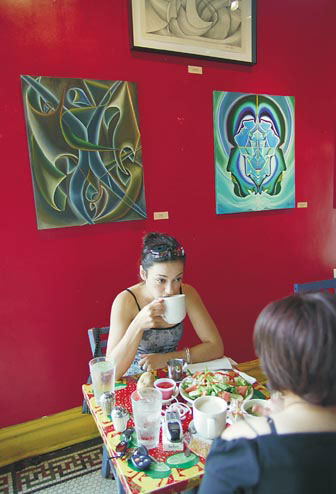 “I had to use a tin tub in a corner near the kitchen and near the exit of the apartment, so I could get the water and dump it in the toilet, which we shared,” Fraga says. “I had to put down newspapers too and a blanket around the tub because I was concerned about water dripping downstairs. We had to get buckets of water from the faucet, fill the tub and then when we were finished, dump the water back in the bucket.”
“I had to use a tin tub in a corner near the kitchen and near the exit of the apartment, so I could get the water and dump it in the toilet, which we shared,” Fraga says. “I had to put down newspapers too and a blanket around the tub because I was concerned about water dripping downstairs. We had to get buckets of water from the faucet, fill the tub and then when we were finished, dump the water back in the bucket.”
After several years, her husband, a carpenter, offered to install a shower himself. The landlord, who lived in Hillside, didn’t think the property was worth even that basic investment.
“He said, `I’d do it myself, but these buildings won’t be here 10 years from now,'” Fraga says.
That was in 1970. More than 30 years later and against heavy odds, many of the historic buildings that seemed to be on the brink of demolition in Pilsen, bordered roughly by 16th Street, Canal, the South Branch of the Chicago River and Damen, have survived. Fraga credits the wave of Mexican immigrants that came to the community beginning after World War II with saving much of the neighborhood.
Fraga became active with Pilsen Neighbors, a community group, in the mid-’70s, when residents mobilized to have a local high school built. That effort led to protests over city plans to demolish large chunks of what was considered a blighted area.
Residents worked with the city on an alternative to the Chicago 21 Plan that called for saving buildings instead of wrecking them. And in the ’80s, Fraga and others fought local banks that wouldn’t make home loans east of Ashland. The banks relented, advertising in Spanish media and on billboards and opening the door to homeownership for many.
 Today, the 59-year-old Fraga owns her own house. She is a school-home coordinator at Orozco Academy, a year away from retirement. After 36 years in Pilsen and three terms as president of Pilsen Neighbors, she faces a challenge she couldn’t have imagined back when she was lugging buckets of water to a shared toilet in a rundown apartment building.
Today, the 59-year-old Fraga owns her own house. She is a school-home coordinator at Orozco Academy, a year away from retirement. After 36 years in Pilsen and three terms as president of Pilsen Neighbors, she faces a challenge she couldn’t have imagined back when she was lugging buckets of water to a shared toilet in a rundown apartment building.
After years of decay and near extinction, after ups and downs and shifting ethnic tides, Pilsen’s colorful, urban, edgy streets are being eyed by real estate developers. What do they want with the area of aging brick cottages and three-flats, homey tacquerias, brilliant ethnic murals and street vendors peddling mango seasoned with lemon and chili?
Pilsen is in a key location, a few minutes southwest of the Loop and on the edge of the expressways. Massive building in the West Loop, South Loop and University Village neighborhoods, the expansion of the adjacent University of Illinois campus and the boom market of the ’90s have put upward pressure on prices in a neighborhood of relatively low incomes.
Residents are happy to see investments and improvement in the community, Fraga says, but many can barely afford their rising property tax bills as it is.
“People are afraid,” Fraga says. “All we have to do is look at history. It’s not an unfounded fear. It’s about your property, your livelihood, where your kids grow up.”
The bus ride up South Halsted Street to the University of Illinois campus was never for the faint of heart. The street was littered with garbage and lined with vacant lots and neglected buildings. At 9 a.m. vendors could be seen hawking pornographic videos and sundry other goods from corners, shouting through a miasma of onions and rotting food.
Today, the vendors are gone (mostly), the garbage gets picked up, and rows of identical red brick rowhouses are replacing the old buildings. The city has invested in new sidewalks and period lighting, and the respectable, homogenous townhomes project their jutting copper bays over a transforming street.
At 86 acres, the $700 million University Village development is one of the largest in the city. It will include more than 930 new condos, townhouses and lofts when complete, as well as dorm rooms and other facilities for the university, and 120,000 square feet of new retail.
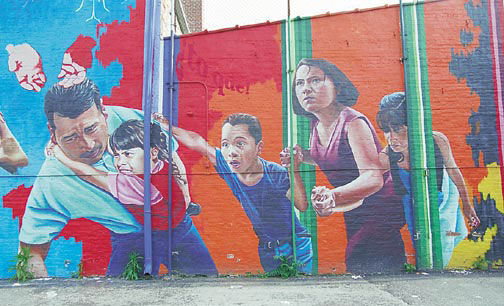 Prices on the townhouses start at nearly $400,000 and go up to more than $700,000. At press time, around half of the units had been sold, and half were under construction, according to Richard Stein, of Mesirow Stein Real Estate. Around two-dozen buyers already have moved into their units, many of which look out over the green of UIC’s athletic fields.
Prices on the townhouses start at nearly $400,000 and go up to more than $700,000. At press time, around half of the units had been sold, and half were under construction, according to Richard Stein, of Mesirow Stein Real Estate. Around two-dozen buyers already have moved into their units, many of which look out over the green of UIC’s athletic fields.
After assembling the land for the project with the city’s help, UIC hired a joint venture team of three builders, Mesirow Stein, the Harlem Irving Companies and New Frontier Companies, to develop the site. Stein says the project is revitalizing what had become a dilapidated area of vacant storefronts and trash-strewn lots into a vibrant new neighborhood.
“It will have a profound effect on the neighborhood,” Stein says. “It already has spurred development in Pilsen, and on Halsted you see all sorts of stuff now. We’ll have about 20,000 square feet of retail in by the end of the year.”
But not everyone is happy with the shape of the new development. Plans for University Village called for clearing away old buildings in much the same way the Chicago 21 Plan called for demolishing large parts of Pilsen.
Rehabber and activist Bill Lavicka helped galvanize opposition with the Maxwell Street Preservation Coalition. The group identified and struggled to preserve architecturally significant buildings around Maxwell Street that the university and its developers wanted to bulldoze.
“UIC bought the buildings, threw out the owners and then said it was slum and blighted,” says Lavicka, whose business, Historic Boulevard Services, has focused on preserving Chicago’s historic architecture.
The open air Maxwell Street Market has a rich history dating back to the 19th century. It evolved over the years from a largely Jewish and Eastern European institution to one where African Americans, Latinos, Asians and others congregated to buy and sell everything from hub caps and tools to dolls and lamps.
Critics of the market say it was a haven for stolen goods. Its main products, they say, were garbage and crime, and it created an eyesore that held back much of the Near West Side. Market supporters say that the city consciously denied services and let infrastructure crumble in the market area rather than invest in it and solve whatever problems existed. When squalor and neglect reached a certain level, the city and UIC were able to grab land that had long been coveted.
These same critics point out that former First Ward Alderman Ted Mazola, who was tireless in his attacks on the market, now stands to make millions on commissions for his company, New West Realty. The South Campus Development Team chose New West as exclusive sales and marketing agent for the project.
Lavicka’s group can, however, claim a partial victory. Eight of the historic facades on Halsted Street have been saved and are being incorporated into the new development. Another 13 have been stored for later use at University Village.
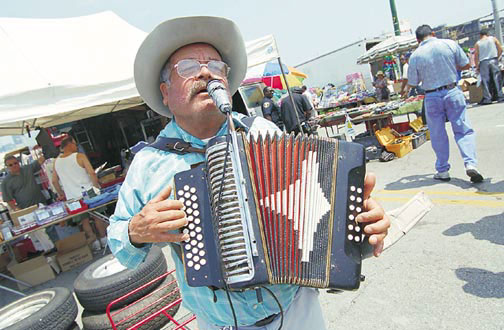 Lavicka still laments the sameness of the expensive new townhouses replacing what he says was a colorful area with variety and character. The West Loop, immediately north of University Village, is full of nearly identical brick mid-rises full of nearly identical pricey new condos, he says. Their residents tend to be singles or young couples who head for the suburbs as soon as they have children. Many don’t stick around long enough to get involved with local parks, schools and institutions.
Lavicka still laments the sameness of the expensive new townhouses replacing what he says was a colorful area with variety and character. The West Loop, immediately north of University Village, is full of nearly identical brick mid-rises full of nearly identical pricey new condos, he says. Their residents tend to be singles or young couples who head for the suburbs as soon as they have children. Many don’t stick around long enough to get involved with local parks, schools and institutions.
But immediately south of the University Village project, which stretches from Roosevelt to 15th along Halsted, Pilsen residents aren’t as worried about aesthetics as they are about prices. The most affordable condos at University Village are priced in the $160s, while the median price for a house in Pilsen was $122,000 during 2001, according to the Chicago Association of Realtors. Pilsen prices are low by citywide standards, but the ’01 median represents a jump of more than 28 percent over the 2000 median of $95,000.
“What we have in Pilsen now is housing that’s affordable to us,” says David Aragon, a community activist. “And with the increases in property taxes, that housing no longer will be affordable to us. We all want to see our neighborhood improve, but we don’t want to be removed as it improves.”
The developers of University Village point out that 21 percent of the project’s housing is reserved as affordable. But half of the affordable units are for people earning up to 100 percent of the metropolitan area’s median income, and the other half for people earning up to 120 percent of the median, which is about $64,000 for a family of four. Residents of Pilsen, where about 35 percent of households make less than $15,000 a year, say the condos aren’t affordable for them.
South of University Village, around 18th, Halsted is buzzing with jackhammers, trucks and city workers as the street is rebuilt. But even without the noise and dirt, these blocks are not pedestrian-friendly. It’s been decades since most of the storefronts held stores, their windows now covered to offer artists and residential tenants some privacy. Truck traffic is heavy and until now, the infrastructure was in poor shape.
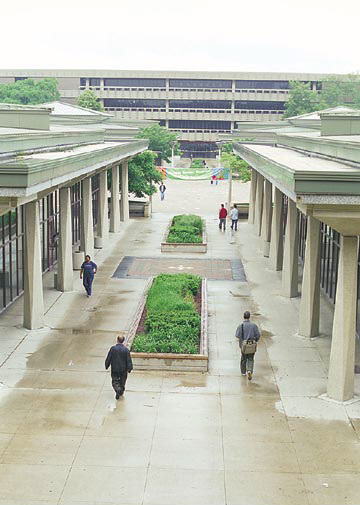 Step through the offices of Podmajersky Management, at 1831 S. Halsted, however, and you’re suddenly in an oasis of quiet green. Loft buildings form a courtyard of lush landscaping, terraced gardens and a gurgling fountain complete with giant goldfish.
Step through the offices of Podmajersky Management, at 1831 S. Halsted, however, and you’re suddenly in an oasis of quiet green. Loft buildings form a courtyard of lush landscaping, terraced gardens and a gurgling fountain complete with giant goldfish.
“This area was a disaster when I came back to take care of my mother and father in the ’50s,” says John Podmajersky, who has made a career of resurrecting Pilsen’s aging buildings. “When they put in the highway, it was like cutting the jugular vein of the neighborhood. There wasn’t enough business to support the retail, and the neighborhood was weak to begin with.”
Podmajersky’s parents came from Slovakia with little education and less English. His father and some partners ran a small dairy, delivering milk on Pilsen’s streets by 13 horse-drawn wagons. Back then, many of the residents were German and Irish immigrants, though the population was shifting to Slovak and Lithuanian, and a little farther west, to Polish.
Podmajersky had been working on buildings since boyhood, and when he returned, he began buying and rehabbing them with no idea how he would draw tenants to such a tough part of town. He found his niche when he was introduced to a group of artists displaced from Hyde Park. They were willing to go almost anywhere for cheap loft space, and they suited the sensibility of Podmajersky, who seems to be equal parts philosopher, visionary and businessman.
“The artists were low maintenance, and they are great people to be around,” says Podmajersky, whose thick white hair, constant smile and enthusiasm make him seem much younger than his 80 years. “I’d rather rent to people who have passion and inspiration in their lives and appreciate beauty. The artists have that and so do the blue-collar people.”
Beauty and inspiration have played a big part in Podmajersky’s evolving efforts over the years to create a sense of community and security under adverse conditions. His own inspiration came during a 1957 trip to Slovakia where he saw enclosed villages and realized that he could connect buildings through green courtyards, providing an inner sanctuary that shut out the neighborhood’s problems.
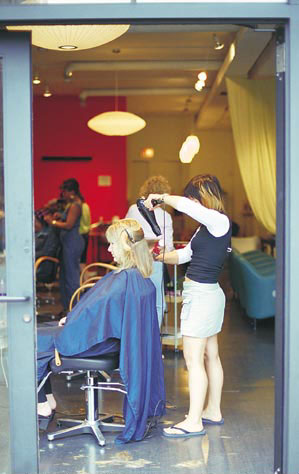 Today, he owns hundreds of units (he won’t say how many exactly) centered along Halsted, as well as on 18th and 19th streets. He says he has spent decades saving, redesigning and “massaging” old buildings to make them work against the odds. Artists give his spaces rave reviews.
Today, he owns hundreds of units (he won’t say how many exactly) centered along Halsted, as well as on 18th and 19th streets. He says he has spent decades saving, redesigning and “massaging” old buildings to make them work against the odds. Artists give his spaces rave reviews.
“I’ve been in every kind of space – storefronts, barns, old nightclubs,” says artist Roy Schnackenberg, who rents a loft from Podmajersky. “After months of looking, a friend referred me here, and I was offered six studios, all equal to this one. There’s nothing else like it. He (Podmajersky) fixes up old buildings with the artist in mind.”
The lofts are full of whimsical touches, exposed brick and beams, soaring ceilings, labyrinthine halls and balconies overlooking manicured gardens. There also is the Sanctuary, the remains of an 1880 Lutheran church at 19th and Peoria, which Podmajersky has redesigned into a stunning space for outdoor weddings and other events. Terraced gardens will separate the church ruins from an outdoor stage his artist tenants can use for readings and performances.
But despite the improvements he’s made over more than 40 years, Podmajersky says, the properties have only lately gained any value, spurred by new construction. The Resurrection Project put nearly 100 new homes in Pilsen through the New Homes for Chicago program and according to Podmajersky, boosted the neighborhood.
He and his son hope to continue what they see as recent momentum by repackaging East Pilsen as “the Chicago Arts District.” Podmajersky’s son, John Podmajersky Jr., is negotiating with a gallery for a 5,000-square-foot space he owns at 1920 S. Halsted, which would have an adjoining sculpture garden. They hope more galleries and specialty retail will follow.
Crafting East Pilsen’s distinct identity as an arts district, according to the younger Podmajersky, is key to revitalizing the neighborhood. Much of Pilsen, he says, supports such a rebirth for the community, and indeed, many residents are happy to see their property values rising. He sees the neighborhood improving dramatically in the next three to five years.
Others worry that improvement will mean displacement for those who can barely afford their current rents or property taxes. That’s what it meant when the University of Illinois was constructed, they say, and when the highways cut a swath through their old neighborhoods.
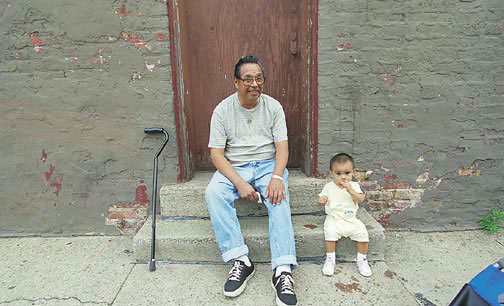 “You had strong communities at Taylor and Halsted, and we were forced out and moved to Pilsen and Little Village,” says Carmen Velasquez, who lived near what is now UIC before coming to Pilsen. Aragon says his family was one of the last to move as buildings were demolished to make way for UIC.
“You had strong communities at Taylor and Halsted, and we were forced out and moved to Pilsen and Little Village,” says Carmen Velasquez, who lived near what is now UIC before coming to Pilsen. Aragon says his family was one of the last to move as buildings were demolished to make way for UIC.
“Now they (UIC) are putting all that high-end housing there, apart from destroying Maxwell Street and displacing all those minority-owned businesses,” Aragon says.
But Velasquez, who founded the Alivio Medical Center in Pilsen, says the neighborhood is strong and organized and though the threat of gentrification is real, “it won’t become Lincoln Park in the next five years.”
There are factors working against gentrification. About 65 percent of the housing stock is renter-occupied, according to Census data, but that number is much lower when it comes to single-family houses, Fraga says. Latino residents have a strong desire to own their own homes, she says, and to rent to friends and family, often at discounted rates.
She believes that these factors, along with the kind of activism that recently forced the city to change the borders of a tax-increment financing district in the neighborhood will prevent a quick turnover. Many homes stay in the family in Pilsen and are passed from one generation to the next, on those rare occasions that they change hands at all. The Chicago Association of Realtors recorded only 15 detached houses sold during 2001 in the neighborhood and only five the year before.
For decades, Lavicka has watched the patterns of development on the Near West Side, the boom in homogenous, pricey condos in the West Loop, the preservation of tiny historic pockets and the devastation of areas with no investment. He has mixed feelings about the pressures on Pilsen.
“If there’s a neighborhood against gentrification, that (Pilsen) is it,” Lavicka says. “And maybe I am too, if it means building more of these condos. But at the same time, you don’t have to go too far to see what happens when a neighborhood has no new investment.”
